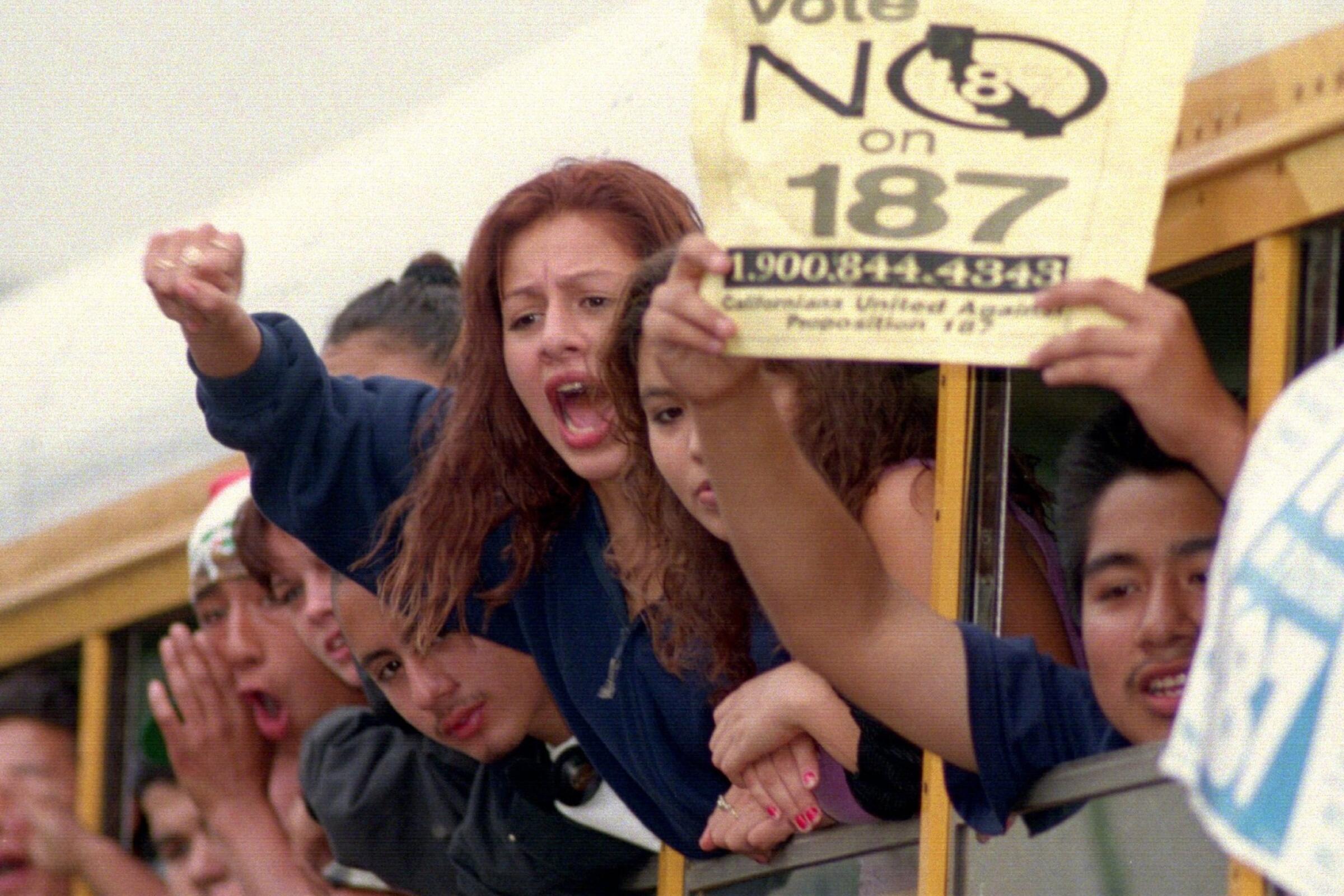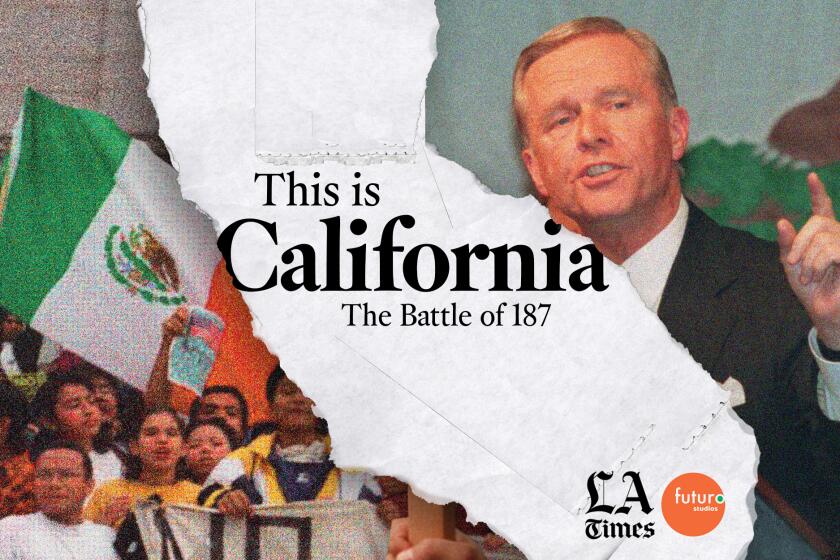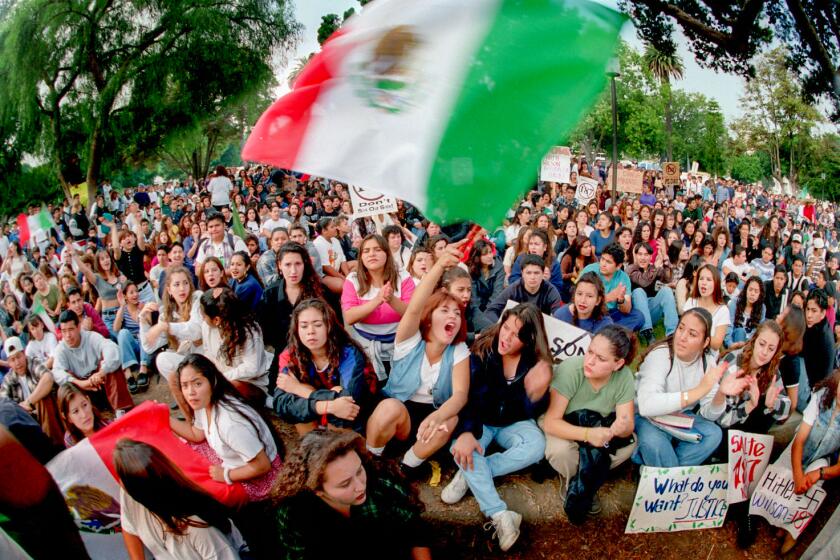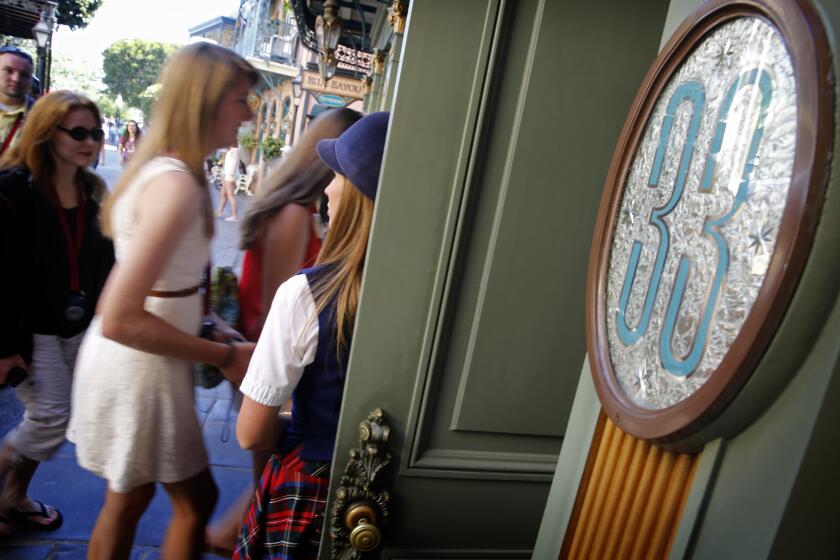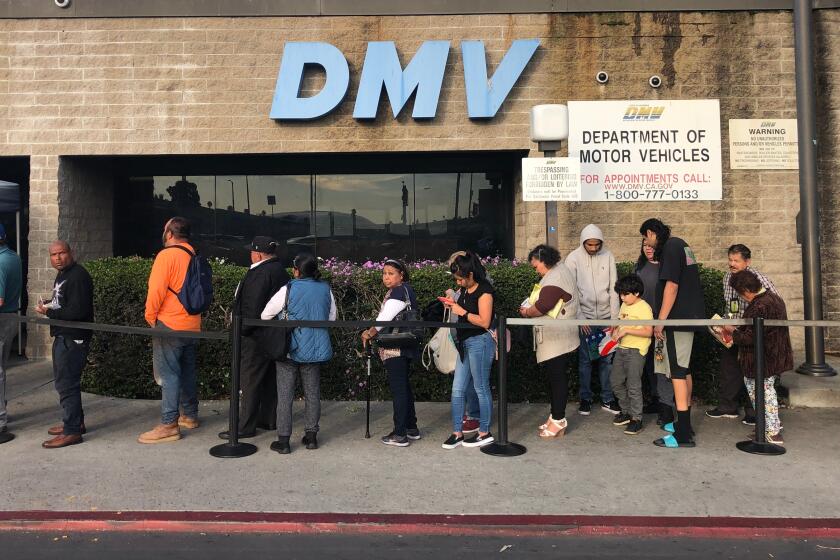Gustavo Arellano is a columnist for the Los Angeles Times, covering Southern California everything and a bunch of the West and beyond. He previously worked at OC Weekly, where he was an investigative reporter for 15 years and editor for six, wrote a column called ¡Ask a Mexican! and is the author of “Taco USA: How Mexican Food Conquered America.” He’s the child of two Mexican immigrants, one of whom came to this country in the trunk of a Chevy.
- Share via
1
The rise of Proposition 187 in California recalls Ernest Hemingway’s oft-cited passage in “The Sun Also Rises,” about how the fortunes of the novel’s main characters changed — gradually, then suddenly.
Increased immigration from Latin America and Asia remade the face of the state but especially Southern California during the 1970s and 1980s. Many longtime residents seethed, but politicians largely remained silent, even in the wake of a 1986 amnesty signed by President Reagan that legalized over 3 million undocumented immigrants, more than half of which resided in the Golden State.
Everything changed with Harold Ezell and Alan Nelson, two immigration officials who used their deep connections with legislators and local activists to plant the seeds for what eventually became Proposition 187. Their efforts finally sprouted in late 1993, just as California faced its worst economic crisis since the Great Depression, and Gov. Pete Wilson faced a tough reelection campaign.
Suddenly, illegal immigration became the issue in California.
Host Gustavo Arellano looks at how Prop. 187 helped turn California into the progressive beacon it is today.
2
July 1986
Immigration and Naturalization Service Western region chief Harold Ezell helps to start Americans for Border Control, the nation’s first citizens group founded to specifically fight illegal immigration. Members of the Orange County-based group attend INS raids in barrios to cheer on immigration agents with signs that say “Don’t Let the USA Become a Third World Nation.”
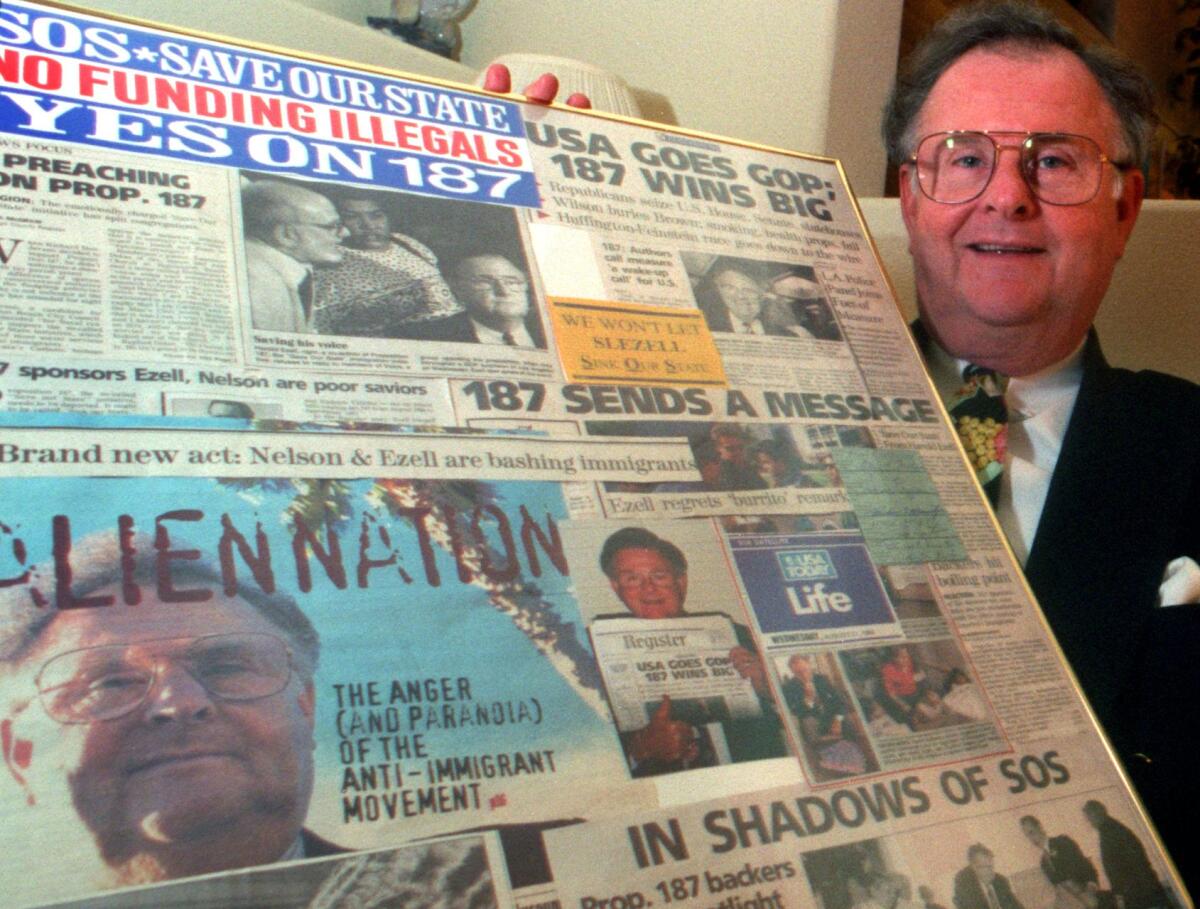
(Alexander Garcia / Los Angeles Times)
3
June 1989
Alan Nelson, Ezell’s former boss, resigns as head of INS. Within three months, he becomes a consultant for the Federation for American Immigration Reform (FAIR), an immigration restrictionist group. For the next five years, Nelson will push California legislators to try and pass bills that seek to ban illegal immigrants from obtaining driver’s licenses, attend public colleges and receive welfare, among other proposals.
4
Nov. 27, 1991
Gov. Pete Wilson’s administration releases a report that claims immigrants will contribute to a $20-billion budget gap in California within a decade.
5
Early 1992
Former Anaheim Police Department employee Barbara Coe and Bill King, a former Border Patrol agent, start Citizens for Action Now in Orange County to fight illegal immigration. Later, the two would create the California Coalition for Immigration Reform, the main grass-roots organization behind what would become Proposition 187.
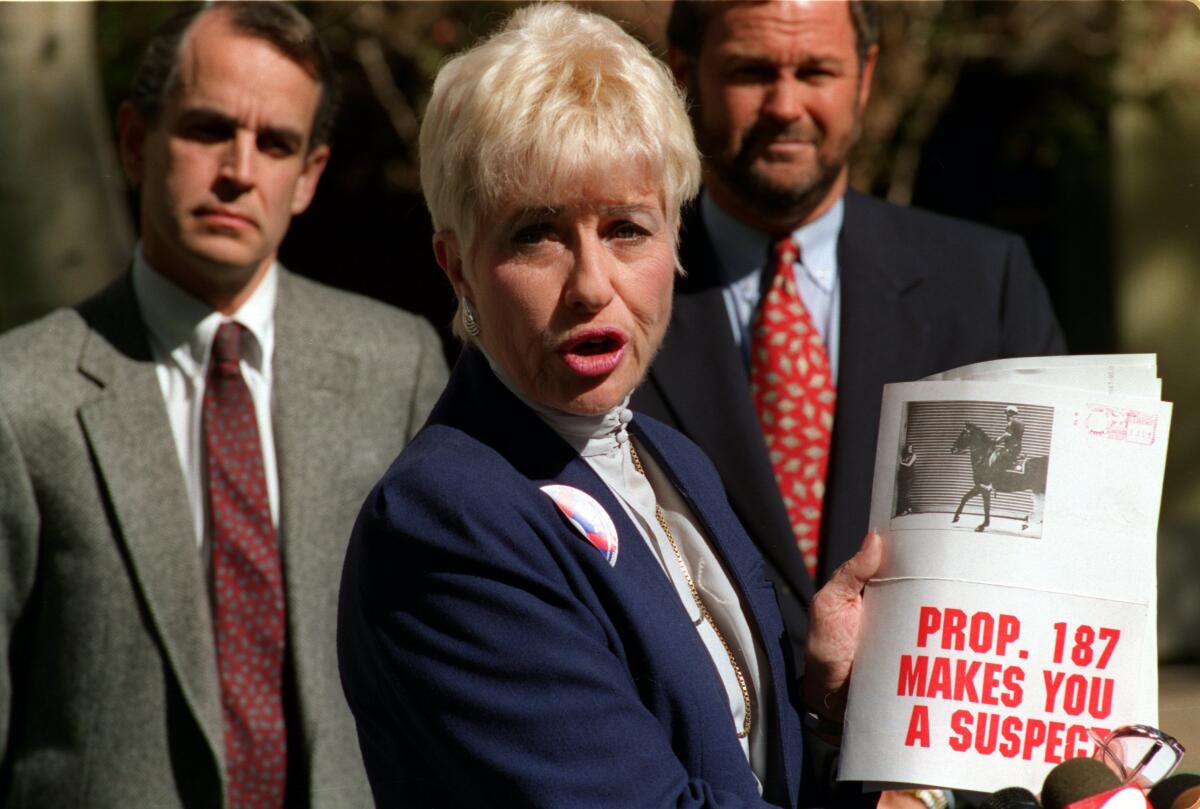
Barbara Coe, founder of the California Coalition for Immigration Reform, displays literature distributed by an anti-Proposition 187 group at a news conference on Nov. 4, 1994. Behind her are Ron Prince, a coauthor of the proposition, and Rep. Dana Rohrabacher, a Proposition 187 supporter.
(Iris Schneider / Los Angeles Times)
6
May 1993
Polls show that California Gov. Pete Wilson trails prospective Democratic challenger Kathleen Brown by 23 points. That same month, over a dozen anti-immigration bills get submitted in both chambers of the California Legislature.
7
Summer 1993
Tustin accountant Ron Prince stands in front of a supermarket in Orange County with a petition that asks, “Do you believe illegal immigration is a problem in California?” After getting hundreds of signatures, he talks to husband-and-wife political consultant team Barbara and Bob Kiley of Yorba Linda, who think his idea for a proposition that would target illegal immigrants just might work.
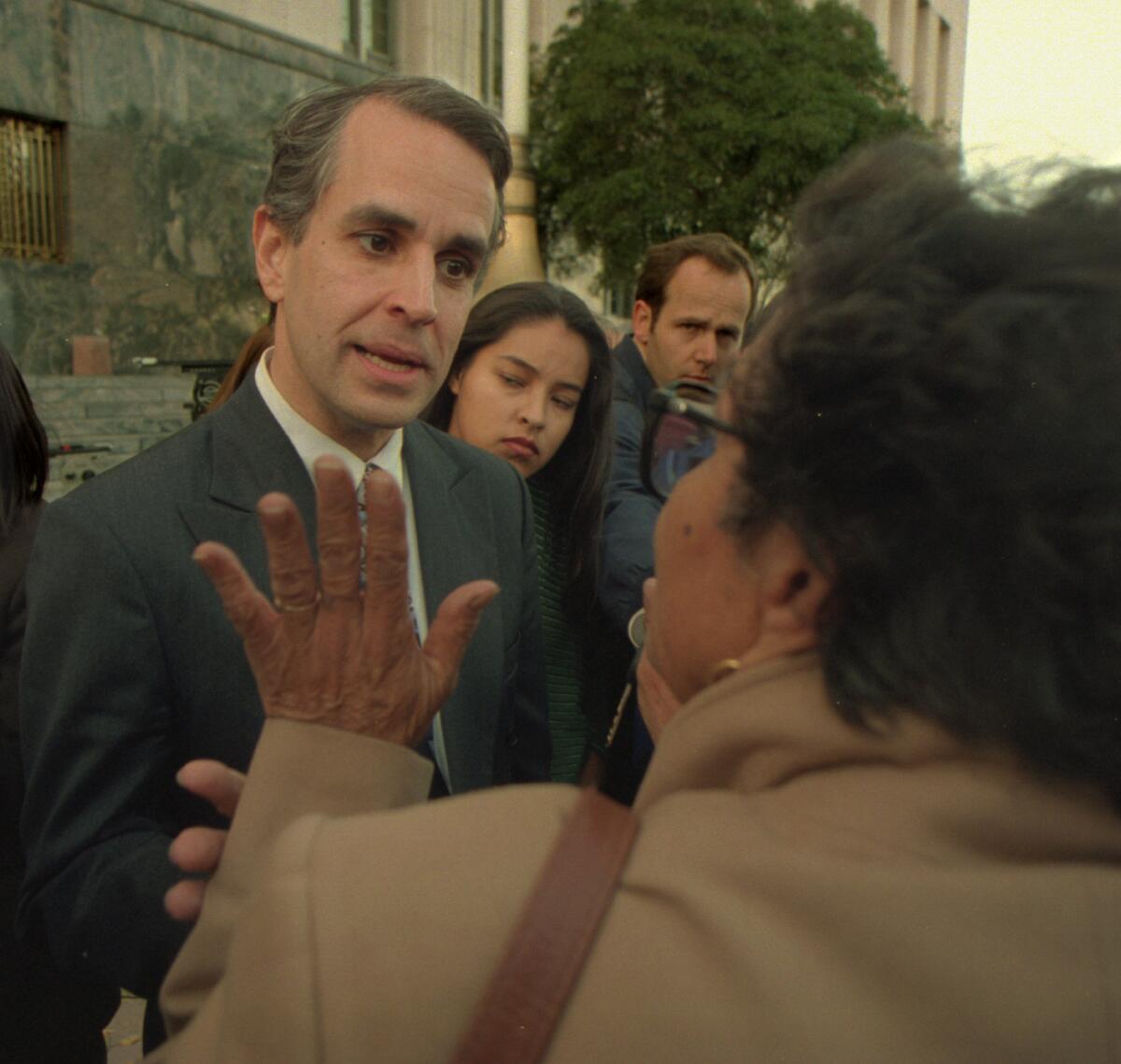
(Robert Durell / Los Angeles Times)
8
Aug. 10, 1993
Pete Wilson proposes Washington end birthright citizenship and social services for illegal immigrants. At a news conference in L.A., he references floods that devastated the Midwest that year before saying “California is being flooded as well. Californians are being overwhelmed by a flood of illegal immigration.”
9
Oct. 5, 1993
At the members-only Center Club in Costa Mesa, the Kileys and Prince meet with Ezell, Nelson, Coe and King to write what would become 187. They decide to name their campaign “Save Our State” after four rounds of margaritas at an El Torito in Orange.
10
Nov. 11, 1993
Save Our State’s initiative is submitted to the California attorney general’s office with Nelson and Ezell listed as co-authors. It’ll need 385,000 valid signatures to qualify for the November 1994 ballot. Los Angeles Assemblyman Richard Polanco immediately criticizes the measure for its “Gestapo approach” to illegal immigration.
11
Jan. 7, 1994
Proponents for Responsible Immigration Debate and Education (PRIDE), a group of Latino legislators and activists, meet with Pete Wilson to ask the governor to tone down his rhetoric on illegal immigration.
12
May 13, 1994
Pete Wilson debuts his “They Keep Coming” ad, drawing widespread criticism for showing shadowy footage of undocumented immigrants crossing the San Ysidro border checkpoint by foot.

(Alexander Gallardo / Los Angeles Times)
13
June 23, 1994
The secretary of state announces that the Save Our State initiative has qualified for the November ballot. It’ll be listed as Proposition 187; the number is also the California penal code designation for murder.
14
July 1994
Californians United Against Proposition 187 hold a conference at Fresno State attended by hundreds of Latino high schoolers and college students. They are debriefed on 187 and urged to organize against it.
15
Sept. 17, 1994
At the California GOP convention in San Diego, Pete Wilson officially endorses Proposition 187. He tells a raucous crowd, “Proposition 187, the Save Our State initiative, is the two-by-four we need to … finally force Washington to accept its responsibility for illegal immigration.”
16
Oct. 16, 1994
More than 70,000 protesters march on L.A. City Hall against 187 — the largest protests Los Angeles has seen since the Vietnam War. But the waving of Mexican flags by many attendees provokes a backlash by liberals and conservatives alike.
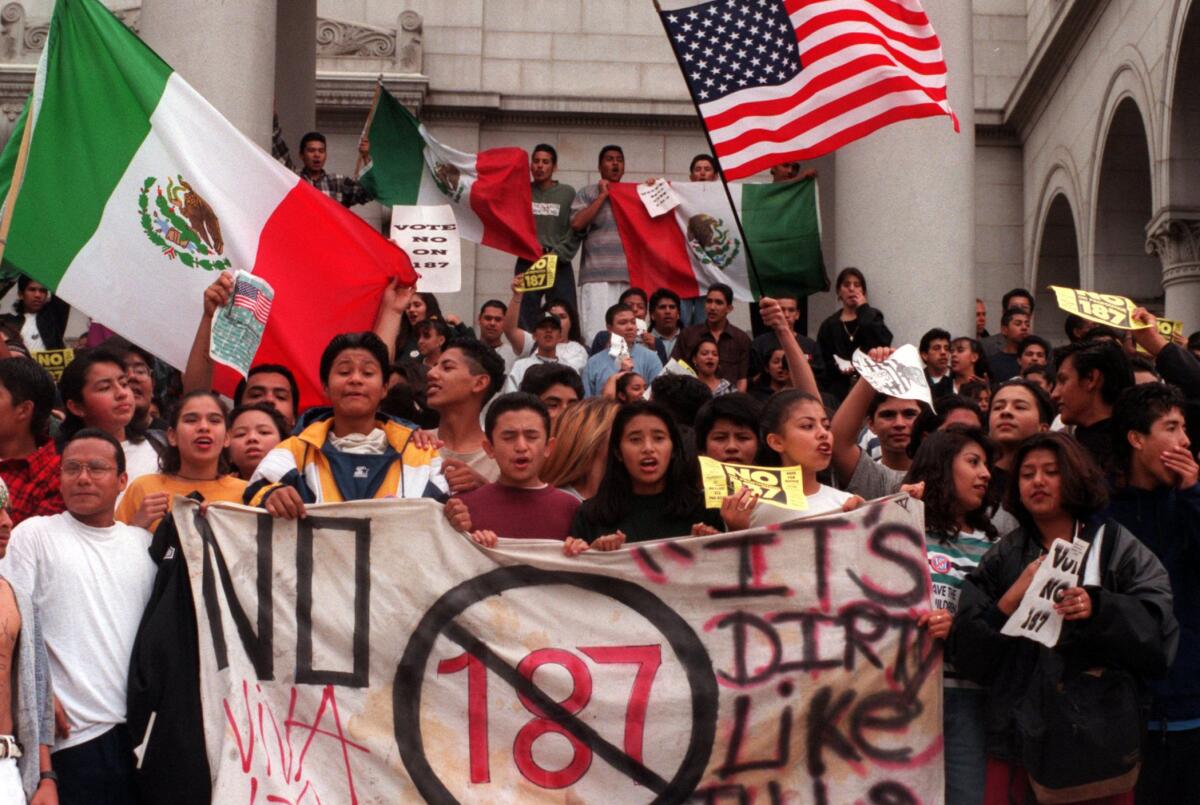
(Bob Carey / Los Angeles Times)
17
Oct. 30, 1994
The Los Angeles Times endorses Pete Wilson — the first time in 24 years the editorial board had backed a California gubernatorial candidate. “While he is utterly, totally, hopelessly wrong on Proposition 187,” the unsigned editorial states, “he has managed successfully to draw attention on the national stage to the plight of states trying to come to terms with problems that ought to be federal responsibilities.”
18
Oct. 31, 1994
Frank del Olmo, then deputy editor of The Times’ editorial pages, writes a rebuttal to The Times’ endorsement of Wilson. “By aligning himself with the immigration issue in its most nativist form, [Wilson] has given legitimacy to an ugly streak of bigotry in California,” Del Olmo writes. “And Latinos everywhere will never forgive him for that.”
19
Oct. 14 - Nov. 7
Middle and high school students across California walk out of high schools to protest 187 in defiance of school administrators and politicians who urge them to stay in class. The biggest day was Nov. 2, when over 10,000 students across Southern California stage coordinated protests.
The student marches were the culmination of a month of anti-Proposition 187 teach-ins, debates, letter-writing campaigns and some of the largest protests California had seen since the Vietnam War.
20
Nov. 8
21
Nov. 9
Eight lawsuits filed in federal and state courts by civil rights groups and public agencies claim 187 is unconstitutional.
22
Nov. 11, 1994
U.S. District Court Judge Matthew Byrne, Jr issues a temporary restraining order on Proposition 187 until it’s heard by federal Judge Mariana R. Pfaelzer.
23
Nov. 20, 1995
Judge Pfaelzer throws out most portions of 187, arguing it tries to supersede federal immigration law.
24
Aug. 22, 1996
Bill Clinton signs a sweeping welfare reform bill that also cuts off federal health and social aid to both legal and illegal immigrants — both key components of Prop. 187.
25
Nov. 8, 1996
The Los Angeles Times reports that “some Republicans are now openly questioning” the wisdom of their party so ardently backing 187 and Wilson two years earlier. Record turnout by Latino voters on election day seemed to indicate that “the use of immigration as a wedge issue served to alienate a fast-growing, generally socially conservative population that could provide ample GOP recruits — especially in the pivotal, heavily populated states where Latinos are concentrated.”
26
Nov. 14, 1997
Judge Pfaelzer rules Proposition 187 is unconstitutional, arguing that Clinton’s welfare bill supersedes 187. The state of California appeals.
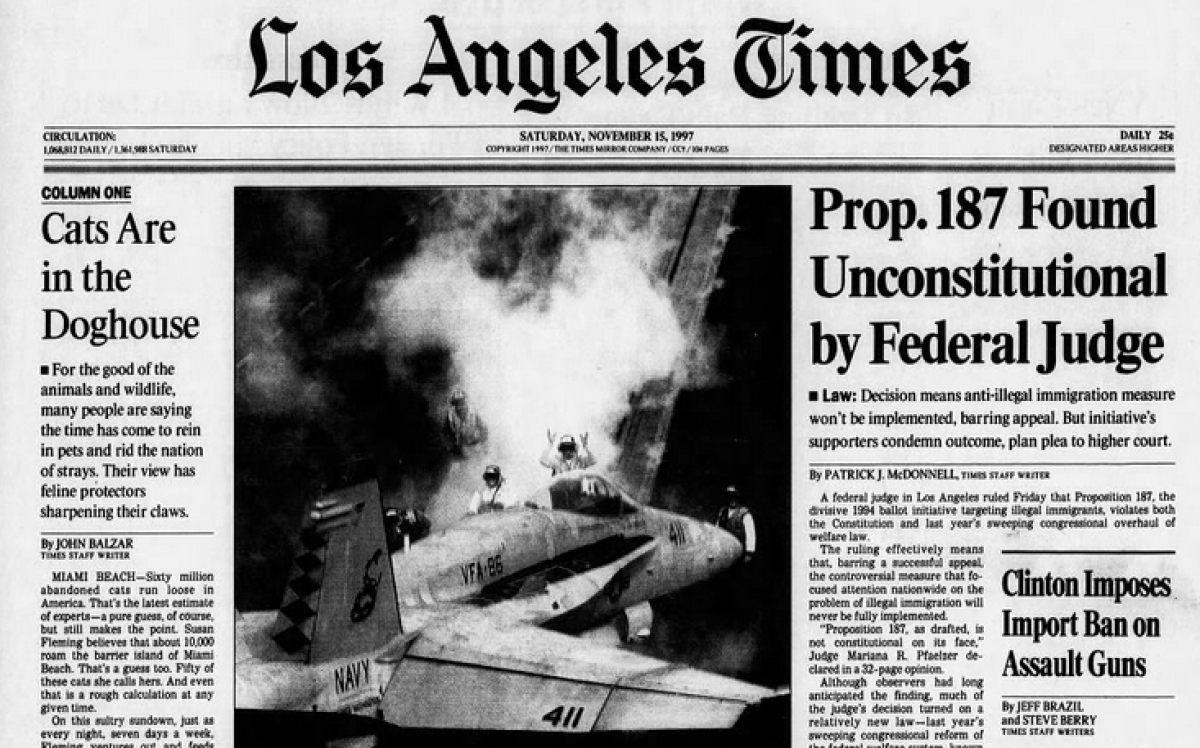
(Los Angeles Times)
27
March 13, 1998
Pfaelzer puts a permanent injunction on 187 as California’s appeal of the case stalls in the 9th District Court of Appeals.
28
July 29, 1999
California Gov. Gray Davis reaches an agreement with anti-187 activists in which he agrees not to continue the state’s appeal. It kills Proposition 187 for good.

29
Sept. 15, 2014
Gov. Jerry Brown repeals the unenforceable sections of 187 from California’s law books.
30
June 23, 2015
The California state Senate passes a resolution that blasts Pete Wilson by name for his “scathing campaign against undocumented parents and their children” during his 1994 reelection bid and “expressly acknowledges the harm caused to Californians through passage of Proposition 187 and its corresponding campaign.” Behind the push is President Pro Tem Kevin de León, one of the main organizers behind the massive 1994 march on L.A. City Hall.
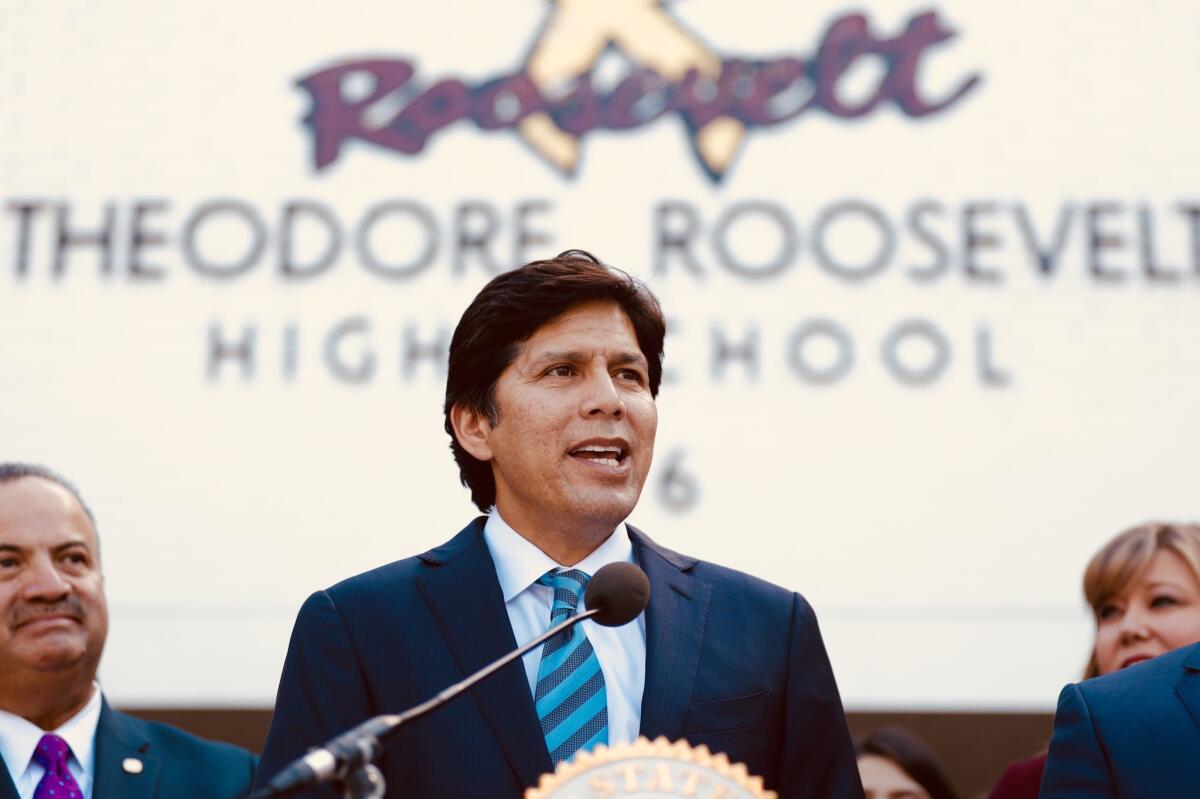
(Gary Coronado / Los Angeles Times)
